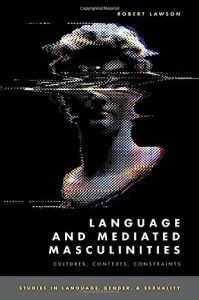In Language and Mediated Masculinities: Cultures, Contexts, Constraints, Robert Lawson interrogates the intersection between language, masculinities and identities in contemporary society. Examining how masculinity is constituted in different media spaces, from newspapers to Reddit forums, this well-researched book urges readers to consider how sociolinguistics shape identity and culture, writes Patrick Munnelly.
Language and Mediated Masculinities: Cultures, Contexts, Constraints. Robert Lawson. Oxford University Press. 2023.
 Written by Robert Lawson, an Associate Professor of Sociolinguistics at Birmingham City University, Language and Mediated Masculinities examines the varied nature of what it means to be masculine and how cultural content, online and off, has shaped the language around masculinity. Lawson takes the view that both culture and language have shaped our views of masculinity over time.
Written by Robert Lawson, an Associate Professor of Sociolinguistics at Birmingham City University, Language and Mediated Masculinities examines the varied nature of what it means to be masculine and how cultural content, online and off, has shaped the language around masculinity. Lawson takes the view that both culture and language have shaped our views of masculinity over time.
Culture and language have shaped our views of masculinity over time.
Lawson begins by reviewing the histories of the words and associated meanings of men, male, and masculinities, asking provoking questions to probe how being male, or not, coincides with masculinity. Lawson uses the early chapters of the book to present these questions and the larger body of literature in the field of language and masculinities studies.
Being a straight, white man, as noted throughout the book, the author takes on a very inclusive and respectful approach to the science behind gender and sexual identity: “…it is the fluid and dynamic assemblage of behaviours, practices, traits, and attributes that people use and adopt in their everyday lives that allows them to be ‘read’ as masculine or feminine… This perspective treats gender as a social endeavour – something that has to be enacted or performed…” (20-21). Lawson draws on research from numerous scholars in the field to adopt this viewpoint of gender as a social construct. Incorporating views on hegemonic masculinity, pulling from R. W. Connell’s 1980s studies, Lawson shows how some people perform their masculinities as “strong” (a traditional trait ascribed to masculinity) through showing emotions and practicing kindness and care, while others perform their version of “strong” as reclaiming the masculinity that has been “feminised” through gay men, men of other races and ethnicities, or anything else that could be interpreted as a deviation from the heteronormative practices of masculinity.
What started as a wholesome movement for men to reconnect to nature and health has since turned dangerous, leading to an increase of suicide rates, shorter life expectancy, and higher rates of being a victim of violent crime among men.
Lawson shows how the language of the the Men’s Rights Movement in the 1980s started out as focusing on men’s health: “[d]rawing on storytelling, rituals, poetry, sports, and crafts, such [Men’s rights groups] gave men the opportunity to gather together for friendship and connection and to reflect on the supposed changes that were affecting their lives” (4), but shifted to attacking feminism as an ideology: “[w]hile the mythopoetic men’s movement suggested that men had to recapture a sense of primal masculinity and homosocial solidarity, the belief among MRAs (Men’s Rights Activists) was that White men were in crisis and that this crisis could be attributed to the growing influence of feminism in American culture” (130). This distortion of culture (femininity, diversity, religious freedom, etc) is the author’s primary argument: what started as a wholesome movement for men to reconnect to nature and health has since turned dangerous, leading to an increase of suicide rates, shorter life expectancy, and higher rates of being a victim of violent crime among men. Ultimately, the movement adopted nebulous views on masculinity and what it means to be a man that resurfaced on the internet where these distorted views doubled down on attacking femininity.
Through the critical discourse analysis and collocation studies presented in chapters four through eight, Lawson sets forth a series of aggregated language concepts that examine how masculinity is perceived. Most notably, in chapters five and six, the author argues that the vitriolic language of the alt-right is contradictory at best; claiming to hate women, many male subscribers to alt-right ideology also “hate men who, in their minds at least, do not measure up to arbitrary, opaque, and indeterminate standards of masculinity, standards which are always shifting and never clearly defined” (166). This can be seen through Lawson’s astute study of context, collocation and culture of the four different subreddits (r/MensRights, r/TheRedPill, r/Incels, and r/MGTOW) where positive, neutral, and negative terms for both men and women are reviewed, in context, against the frequency with which these phrases appear in each forum. The results of the studies back up the author’s assertions that the contemptuous approach of the reinvigorated Men’s Right Movement has focused on hating men who appear as weak or feminine, while simultaneously attacking women for being both unavailable and poisonous to the “other” men.
A possible flaw in the research is that Lawson uses only a few forums on fatherhood and one TV show as exemplary sources of positive masculinities. Readers could come away with the impression that alt-right, toxic men’s rights activists greatly outnumber those rejecting the rhetoric. More pop culture, news reactions, and safer internet sources could have been reviewed using the same methodology as the Reddit forums to give a broader, more balanced picture of how masculinity features across cultures.
Alt-right groups consider men and masculinity – that is, the straight, white, Christian male – to be under threat from the feminisation of society through emotions, feelings, homosexuality, other races, lack of sexual or subordinate interest from women, and other religions.
The author makes the case that such alt-right groups consider men and masculinity – that is, the straight, white, Christian male – to be under threat from the feminisation of society through emotions, feelings, homosexuality, other races, lack of sexual or subordinate interest from women, and other religions. Yet, “[a]t the same time, however, a number of threats lay claim to White men as exemplars of cultural superiority and intellectual rationality… Taking these two discourses together, a narrative which positions White men simultaneously as cultural victims and cultural saviors is advanced” (118). This contradictory viewpoint is established throughout the book as a fallacy, created by the dominant culture feeling “threatened” by the non-dominant groups, an issue that may well worsen as White men and Christianity are projected to become the minority in America.
In this contemporary review of gender, sexuality, identity, and culture, academic and non-academic readers alike are pushed to understand how the reinvigoration of men’s rights as a reaction to social progressivism is a destructive force that threatens progress.
Lawson ends with a series of questions that can be asked from the data showcased in the book. He encourages further investigation of how the language and semantics of ideologies and extremism can be studied not only to understand its divisive effects, but also to deradicalise those swayed by such ideologies and, ultimately, to prevent their spread in the future. In this contemporary review of gender, sexuality, identity, and culture, academic and non-academic readers alike are pushed to understand how the reinvigoration of men’s rights as a reaction to social progressivism is a destructive force that threatens progress. A well-researched contribution to sociolinguistic studies, this book challenges readers to consider how language shapes how we define and orientate ourselves in the world, and how it can be used to push certain narratives and rhetorical stances.
Note: This review gives the views of the author, and not the position of the LSE Review of Books blog, or of the London School of Economics and Political Science. The LSE RB blog may receive a small commission if you choose to make a purchase through the above Amazon affiliate link. This is entirely independent of the coverage of the book on LSE Review of Books.
Main Image: photo-lime on Shutterstock.







